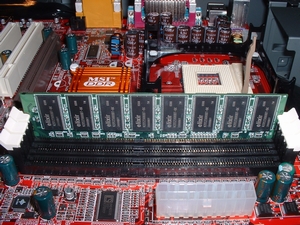The answer to the above question is governed by a few factors. First of
all, if you already have a computer that you do not intend to significantly upgrade, you
are limited to the type of memory that your current motherboard supports. The chipset
of a motherboard is the collection of chips and circuits that allow the
components of your computer to work together, and is tied to a
specific kind of memory, SDRAM, DDR-SDRAM or RDRAM.
As a general rule, to add x amount
of memory to your system, you need a single memory module of that size, of the
same type and speed that your system currently uses (note that type does not
mean the brand of the memory, but rather whether it is SDRAM, DDR
or RDRAM). This information should be easily attained from your motherboard manual.
There are of course exceptions to this rule.
Here are some common ones....
In theory, any system that uses
SDRAM can use memory that is rated faster than the requirements of the
motherboard, as well as memory of the correct speed. For example, an older Intel
Celeron system would use a 66Mhz clock speed, and thus would require PC66 SDRAM,
but could also make use of PC100 and PC133 SDRAM, which it would simply access
at 66Mhz. Note that this is not necessarily possible in the real world, as
voltages and other factors have changed since SDRAM was introduced, and it is a
good idea to stick with the recommended memory, but it is possible.
Some recent chipsets support
more than one type of memory, generally SDRAM and DDR-SDRAM. Consult your
motherboard manual for information on this one, but note that if your board does
support this, you cannot mix both types. Some DDR and RDRAM chipsets use
dual-channel memory, meaning that two separate memory modules on the motherboard
are accessed at the same time, doubling the maximum memory bandwidth. This
requires that the memory be installed in identical pairs on the board, rather
than single modules as is generally the case. Again, consult your manual.
Also, you will need
to verify that you have space on your motherboard to install more memory. Since we
are going to tell you how to actually install it later in the article, the easiest
way to do this is to open up the computer and physically check how many
open memory slots you have.
Regardless of the type of memory you use, they will look
more or less like this.

If you
are planning on purchasing a new system, your choice of memory is going to be
governed by the type of processor you select. PCStats has several excellent
articles on the newest processor and memory combinations
to help you research. Keep in mind that, as with all other computer components,
the price is governed by the relative newness and availability of the memory.
Right now, DDR2100 and PC133 SDRAM are the cheapest and easiest to find, but
since both Intel and AMD are using higher rated DDR-SDRAM for their newest
processors, this will change soon. It does seem that DDR-SDRAM of PC3200 speed
and above is going to be the memory of choice for the near future anyhow, as
both Intel and AMD are using it for their next generation 64bit processors.

